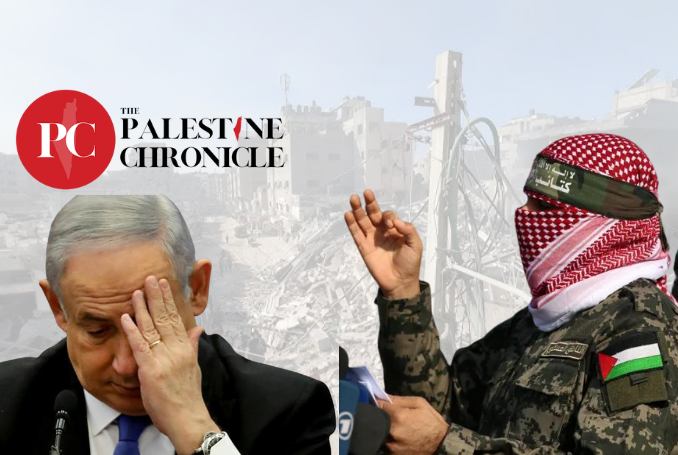
Hamas is currently in a position where it must try its best to negotiate the entry of sufficient aid into Gaza, while also ensuring the war ends and a post-war administration is formed so that the territory can be revived and rebuilt.
On Monday, Hamas’ Al-Qassam Brigades spokesman, Abu Obeida, issued a statement asserting that in light of Israeli ceasefire violations, it will be postponing the prisoner exchange planned for the coming weekend. While this is now being framed as the potential reason for the agreement’s collapse, it is instead a negotiating tactic at a crucial juncture.
“The handover of the Zionist prisoners who were scheduled to be released next Saturday…will be postponed until further notice,” announced the military spokesperson of Hamas. This message was also accompanied by “we affirm our commitment to the terms of the agreement as long as the occupation commits to them”.
While Israeli politicians instantly began claiming that Hamas had violated the ceasefire agreement, with the infamous partner in Israeli PM Benjamin Netanyahu’s far-right coalition, Itamar Ben-Gvir, calling for an immediate bombing campaign, nothing has materially changed on the ground yet. However, provocative statements like Ben-Gvir’s are predictable and also important in this equation.
Abu Obeida Says Release of Israeli Detainees Delayed Due to Israeli Violations
Following Abu Obeida’s statement, in which he accused Israel of violating the ceasefire terms, the Hamas movement decided to publish a list of multiple Israeli violations of the deal, including:
- “Delaying the return of displaced persons to northern Gaza.”
- “Targeting civilians with shelling and gunfire, resulting in numerous casualties across the Strip.”
- “Obstructing the entry of essential shelter supplies, such as tents, prefabricated houses, fuel, and equipment needed for rubble removal and body retrieval.”
- “Delaying the delivery of critical medical supplies and resources necessary for restoring hospitals and the health sector.”
While Hamas stated that it had itself recorded the above-mentioned ceasefire violations, these have been well documented by rights groups, journalists and have been mentioned by United Nations officials. Yet, Israel’s violations began some 15 minutes after the planned implementation of the deal – on January 19 at 8:30 AM (local time).
Killings of civilians through airstrikes and sniper fire continued throughout the following weeks, amongst the other ceasefire violations, however, Hamas had chosen not to open fire; or even release threatening statements in retaliation such as what occurred today.
Why is Hamas Doing This Now?
The knee jerk analyses that are being offered by most analysts in the immediate aftermath of the Hamas statement are almost entirely centered on a kind of he-said-she-said approach to the issue. As these disputes rage on about who violated the ceasefire and which side seeks the collapse of the deal, it is important to look deeper into the context.
As noted above, Hamas had chosen to not fire a single bullet or rocket, nor threaten to postpone the release of Israeli captives, through weeks of daily Israeli ceasefire violations. There were moments when Israeli forces were executing children, delaying the return of displaced Palestinians to their homes for 24 hours and restricting essential items from reaching the Gaza Strip, all of which would have given Hamas the moral imperative to obstruct the deal in order to end such violations of the agreement.
If Hamas held off from retaliation for emotional, legal and moral reasons, then it indicates that their statements from today were strategically calculated and not simply reactionary. The timing of the Qassam Brigades spokesman’s statement happened to coincide with the return of the Israeli negotiating team from Doha, which also appears to be connected.
Within the past week, Israeli PM Benjamin Netanyahu has changed the composition of his negotiating team, reportedly floating the idea of an extension to the first phase of the ceasefire agreement. These amendments to the course of the negotiating process have been compounded by US President Donald Trump’s threats to take over the Gaza Strip, in addition to ethnically cleansing the territory’s population.
Israel has also now withdrawn its forces from the Netzarim Corridor that intersects northern and central Gaza, deserting what would be a key military position should they seek to return to the territory, while most of the displaced refugees from the north of the territory have also returned to their destroyed neighborhoods.
Trump’s Gaza ‘Ownership’ Proposal Will Not Work: This is Why – Analysis
Another factor to consider is that the Israeli PM has managed to keep his far-right coalition together so far, yet, key lawmakers from within the Religious Zionism bloc have threatened to collapse the government should it approve phase two of the three-phase ceasefire agreement. Interestingly enough, Donald Trump’s rather outlandish and highly illegal proposals have managed to persuade Netanyahu’s hardline coalition partners that the ceasefire is a good deal, quite possibly helping to save it.
Emboldened by the American President’s hardline rhetoric, Netanyahu has since gone on a number of tirades in which he has not only endorsed the idea of ethnically cleansing the people of Gaza to neighboring nations, but has even said that Saudi Arabia should carve out part of its territory to make a Palestinian State.
These extreme threats have now managed to ironically unite West Asia, not with Israel but against it. Contrary to the claims of Netanyahu and Trump, about Riyadh abandoning its position on requiring a viable path to a Palestinian State in exchange for a normalisation agreement with Tel Aviv, it has only doubled down. In fact, the condemnatory rhetoric of Israel, coming from Saudi Arabia, is the strongest in decades.
Hamas has been center stage in this sudden, seemingly overnight regional shift, which has certainly factored into their decision to begin applying pressure on the Israeli negotiating team.
The Hashemite ruler of Jordan, King Abdullah II, has been publicly starkly opposed to the US-Israeli proposal to transfer hundreds of thousands, if not close to a million Palestinians, out of Gaza and into his territory. While the Egyptian military has reportedly been mobilizing to deal with any major destabilizing development. Both Cairo and Amman fear the potential repercussions for the survival of their leadership should a mass displacement from Gaza occur.
Saudi Arabia, meanwhile, has also been placed in a difficult position. Like Jordan and Egypt, it is friendly to not only the US, but also Israel. Yet, taking into consideration the fall of Bashar al-Assad’s government in Syria, in addition to the popular moods of the Saudi people in support of the Palestinian cause, normalizing with Israel right now and enabling a major regionally destabilizing event that could even cause the collapse of the Jordanian Monarchy, is a risk they are not willing to currently take.
Another major factor here is both the warming of relations between Riyadh and Tehran, combined with the recent weakening of the Iranian-led Axis of Resistance. This essentially means that there is little to gain from joining an anti-Iran alliance, likely re-igniting its frozen conflict in Yemen, with little role for it to actually play. In such a scenario, Saudi Arabia would be fully subordinate to the US, which limits future opportunities in the emerging multipolar world. Saying this, the threat of destabilization inside Saudi Arabia goes both ways, if they go too far in opposition to the Americans and Israelis, they could also incur their wrath.
Foreign Hands in Gaza: How the West is Working to Rob Gaza of Democracy
Hamas decided to release its statement, doing so with a region that is now united against the Israeli-US invasion/ethnic cleansing plan. The Arab and Islamic nations will soon likely adopt a joint platform and help in putting forth urgent proposals to see the Gaza ceasefire’s implementation through the second and third phases. This includes throwing their weight behind the success of a post-war administration in the Gaza Strip.
Israel on the other hand has little leverage in this situation, other than to implement plans that will inflict mass regional destabilisation and return to carrying out its catastrophic genocide in Gaza. This is why, so far, the Israeli threats against Gaza have been centered around what their response will be if there is a failure to exchange prisoners on Saturday, which is five days away.
If Israel carries out airstrikes in the coming days, it has two options, to completely collapse the ceasefire or to just carry out random raids that will kill civilians, but not in a way that would lead to the ceasefire’s dissolution. However, there is also a trap in the Israelis deciding to carry out any significant raids on Gaza, because this will then give Hamas – and perhaps its ally Ansarallah – the excuse to respond in kind.
If Hamas fires volleys of rockets toward Israeli settlements, possibly even Tel Aviv, it will serve as a great embarrassment to Israeli Premier Benjamin Netanyahu and could even encourage his extremist allies to threaten the collapse of his coalition. In the minds of Netanyahu’s partners like Bezalel Smotrich and Itamar Ben-Gvir, they believe that Hamas must be crushed and the entirety of the Palestinian population be driven out. Therefore, Hamas’ rocket fire could trigger emotional reactions from them that put Netanyahu in a difficult political position.
Meanwhile, the families of Israeli captives who are still held in Gaza have already taken it upon themselves to blockade main roads in Tel Aviv, demanding the implementation of the ceasefire agreement.
Hamas is currently in a position where it must try its best to negotiate the entry of sufficient aid into Gaza, while also ensuring the war ends and a post-war administration is formed so that the territory can be revived and rebuilt. Although it may be a dangerous gamble on their behalf, it appears to be an attempt to use the current climate to pressure the Israelis to allow the passage of sufficient aid, while also paving the way to the success of the next phases of the ceasefire deal.
The wildcard here is a potential US-Israeli plot to use insane levels of violence that will sink the entire region into chaos.

– Robert Inlakesh is a journalist, writer, and documentary filmmaker. He focuses on the Middle East, specializing in Palestine. He contributed this article to The Palestine Chronicle.